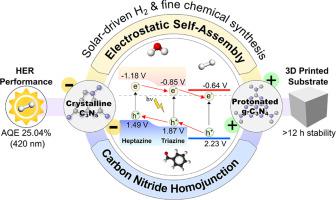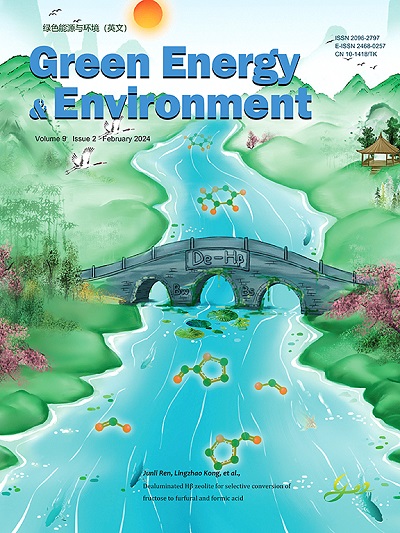2D/2D homojunction-mediated charge separation: Synergistic effect of crystalline C3N5 and g-C3N4 via electrostatic self-assembly for photocatalytic hydrogen and benzaldehyde production
IF 14.6
1区 工程技术
Q1 CHEMISTRY, PHYSICAL
引用次数: 0
Abstract
Homojunction engineering is a promising modification strategy to improve charge carrier separation and photocatalytic performance of carbon nitrides. Leveraging intrinsic heptazine/triazine phase and face-to-face contact, crystalline CN (CC3N5) was combined with protonated g-CN (pgCN) through electrostatic self-assembly to achieve robust 2D/2D homojunction interfaces. The highest photocatalytic performance was obtained through crystallinity and homojunction engineering, by controlling the pgCN:CC3N5 ratio. The 25:100 pgCN:CC3N5 homojunction (25CgCN) had the highest hydrogen production (1409.51 μmol h) and apparent quantum efficiency (25.04%, 420 nm), 8-fold and 180-fold higher than CC3N5 and pgCN, respectively. This photocatalytic homojunction improves benzaldehyde and hydrogen production activity, retaining 89% performance after 3 cycles (12 h) on a 3D-printed substrate. Electron paramagnetic resonance demonstrated higher ·OH, ·O and hole production of irradiated 25CgCN, attributed to crystallinity and homojunction interaction. Thus, electrostatic self-assembly to couple CC3N5 and pgCN in a 2D/2D homojunction interface ameliorates the performance of multifunctional solar-driven applications.

二维/二维同质结介导的电荷分离:通过静电自组装实现晶体 C3N5 和 g-C3N4 在光催化制氢和苯甲醛生产中的协同效应
同质结工程是改善碳氮化物电荷载流子分离和光催化性能的一种前景广阔的改性策略。利用固有的庚嗪/三嗪相和面对面接触,通过静电自组装将结晶 CN(CC3N5)与质子化 g-CN(pgCN)结合在一起,实现了稳健的 2D/2D 同质结界面。通过控制 pgCN:CC3N5 的比例,结晶度和同结工程获得了最高的光催化性能。25:100 pgCN:CC3N5 同质结(25CgCN)的产氢量(1409.51 μmol h)和表观量子效率(25.04%,420 纳米)最高,分别比 CC3N5 和 pgCN 高 8 倍和 180 倍。这种光催化同质结提高了苯甲醛和氢气的生产活性,在三维打印基底上循环 3 次(12 小时)后,性能保持率仍高达 89%。电子顺磁共振显示,辐照 25CgCN 产生的-OH、-O 和空穴更多,这归因于结晶度和同质结的相互作用。因此,通过静电自组装将 CC3N5 和 pgCN 结合到二维/二维同质结界面中可改善多功能太阳能应用的性能。
本文章由计算机程序翻译,如有差异,请以英文原文为准。
求助全文
约1分钟内获得全文
求助全文
来源期刊

Green Energy & Environment
Energy-Renewable Energy, Sustainability and the Environment
CiteScore
16.80
自引率
3.80%
发文量
332
审稿时长
12 days
期刊介绍:
Green Energy & Environment (GEE) is an internationally recognized journal that undergoes a rigorous peer-review process. It focuses on interdisciplinary research related to green energy and the environment, covering a wide range of topics including biofuel and bioenergy, energy storage and networks, catalysis for sustainable processes, and materials for energy and the environment. GEE has a broad scope and encourages the submission of original and innovative research in both fundamental and engineering fields. Additionally, GEE serves as a platform for discussions, summaries, reviews, and previews of the impact of green energy on the eco-environment.
 求助内容:
求助内容: 应助结果提醒方式:
应助结果提醒方式:


